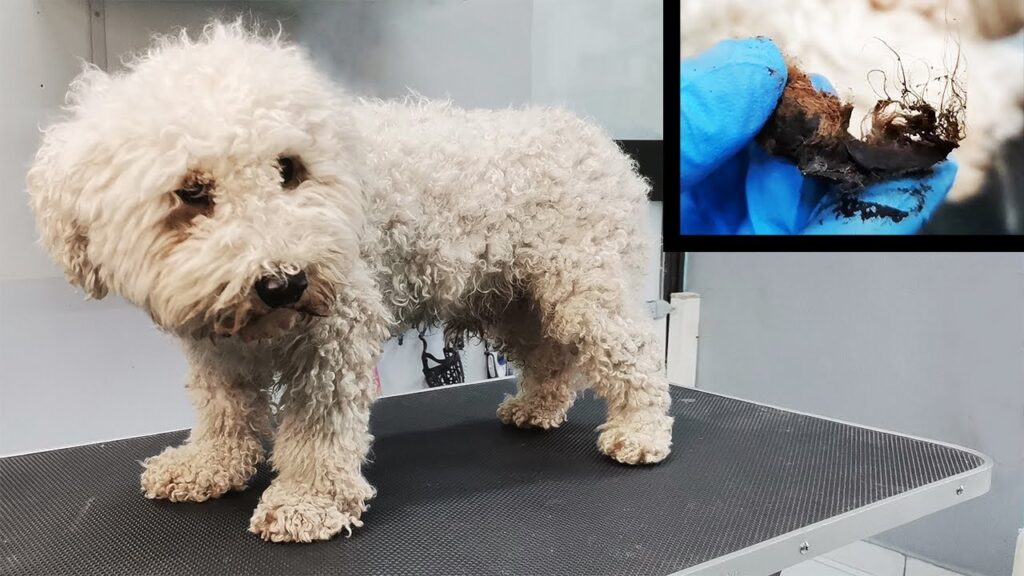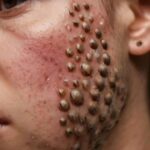The boundless energy and unwavering loyalty of your canine companion are truly heartwarming. Amid the joyful moments, however, the challenge of matted dog hair can arise, impacting both their comfort and appearance.
In this guide, we explore the key factors behind matting and unveil effective preventive strategies to ensure your furry friend’s coat remains healthy, sleek, and free from tangles. Join us as we embark on a journey to discover the secrets of maintaining a well-groomed and contented canine companion.

Why does dog hair get matted?
Dog hair becomes matted primarily due to a combination of factors involving shedding, tangling, and lack of proper grooming. Here’s a breakdown of the main reasons behind matted dog hair:
- Shedding: Dogs naturally shed old or damaged hair to make way for new growth. If this shed hair is not regularly brushed out, it can become entangled with the remaining coat, forming mats over time.
- Tangling: Dogs with longer, curly, or wavy coats are more prone to tangling and matting. Activities like running through underbrush or rolling around can cause the fur to tangle, creating a breeding ground for mats.
- Lack of Grooming: Regular grooming, including brushing and combing, is essential to prevent mats from forming. When loose hair isn’t removed, it accumulates and knots up, eventually turning into stubborn mats that are difficult to untangle.
- Moisture and Dirt: Wet or dirty fur is more likely to mat. Moisture causes the fur to clump together, especially in areas prone to friction like armpits and behind the ears. Dirt can contribute to the clumping, exacerbating the matting problem.
- Neglected Undercoat: Breeds with double coats have a dense undercoat that can easily mat if not properly maintained. The undercoat traps loose fur and can become a breeding ground for tangles.
- Medical Conditions: Dogs with certain medical conditions, such as skin allergies or mobility issues, might have difficulty grooming themselves, leading to mats forming in hard-to-reach areas.
- Matted Areas: Once a small mat forms, it can quickly attract more loose hair, making it grow in size. Mats near the skin are particularly problematic as they can cause discomfort and potentially lead to skin irritation or infections.
How to prevent the matting of dog hair
Preventing the matting of dog hair requires a combination of regular grooming, proper maintenance, and attention to your dog’s specific coat type. Here are some effective strategies to keep your canine companion’s coat mat-free:
Regular Brushing
Brushing your dog’s coat on a consistent basis is one of the most effective ways to prevent matting. Regular brushing removes loose hair, dirt, and debris, preventing them from getting tangled in the fur. Depending on your dog’s coat type, choose an appropriate brush – slicker brushes for longer coats and bristle brushes for shorter coats. This practice also helps distribute natural oils throughout the coat, promoting its health and luster.
Use Detangling Products
For dogs with longer or easily tangled coats, consider using detangling sprays or conditioners. These products help soften the fur and make it easier to comb through without causing discomfort. Gently work the detangling product into the coat, starting from the tips and working your way up toward the skin.
Choose the Right Grooming Tools
Selecting the right grooming tools is essential to effectively prevent matting. Consult with professional groomers or your veterinarian to identify the most suitable brushes, combs, and tools for your dog’s specific coat type. Using the appropriate tools ensures that you’re able to remove tangles and knots without causing unnecessary stress or discomfort to your furry friend.
Focus on Problem Areas
Certain areas of your dog’s body are more prone to matting than others. Concentrate your grooming efforts on these trouble spots, such as behind the ears, under the armpits, and around the tail. Regularly check these areas and gently comb through them to prevent mats from forming. Consistent attention to these regions helps maintain overall coat health.
Bathe and Dry Properly
After bathing your dog, ensure that their coat is thoroughly dry before allowing them to roam around. Wet fur is more susceptible to tangling and matting. Use a blow dryer on a low setting to ensure complete drying, while also preventing moisture from getting trapped in the fur. Make sure not to use excessive heat that could harm your dog’s skin.
Trim or Clip Long Hair
If your dog has a long coat that is prone to tangling, consider occasional trimming or clipping. Trimming the hair to a manageable length reduces the risk of mats forming. While this might alter your dog’s appearance, it can significantly ease the maintenance of their coat and reduce the chances of discomfort associated with matting.
Professional Grooming
Regular visits to a professional groomer are especially important for breeds with high maintenance coats. Groomers have the expertise and specialized tools to tackle mats safely and effectively. Regular grooming sessions not only address existing mats but also help prevent future ones by keeping the coat in optimal condition.
Positive Reinforcement
Make grooming a positive experience for your dog by using treats, praise, and patience. Associating grooming with positive rewards can help reduce anxiety and resistance. A calm and relaxed demeanor during grooming sessions also makes it easier to comb through the coat without inadvertently causing tangles.
Prevent Outdoor Tangles
During outdoor activities, avoid areas with tall grass, burrs, or debris that can easily tangle the coat. Regularly check your dog’s fur for any foreign objects caught within it. Taking preventative measures while outdoors can significantly reduce the risk of mats forming due to environmental factors.
Maintain a Healthy Diet
A balanced diet rich in essential nutrients is vital for healthy coat growth. Nutritional deficiencies can lead to dry, brittle fur that is more prone to matting. Consult your veterinarian to ensure that your dog’s diet is providing the necessary nutrients to support a soft, manageable coat.
What to do if your dog’s hair is already matted?
When faced with matted dog hair, two main options emerge: tackling the task yourself or seeking professional help from a groomer. If the mats are small and loose, you can attempt to demat the hair at home. Check out our guide on how to groom a dog for more details on how to tackle grooming by yourself.
However, for extensive matting, tightly bound knots, or if you’re uncertain about the process, it’s advisable to consult a professional groomer. Groomers possess the expertise and tools to remove mats safely and efficiently, ensuring your dog’s comfort throughout the process.
Conclusion
In the journey of pet ownership, managing matted dog hair requires thoughtful consideration. Whether you tackle it yourself or rely on a professional groomer, your furry friend’s comfort is paramount. Small mats can often be coaxed out with patience and the right tools, while complex matting may necessitate a groomer’s expertise. Remember, regular grooming and attentive care are key to a soft, shiny, knot-free coat, nurturing the bond between you and your beloved companion.










